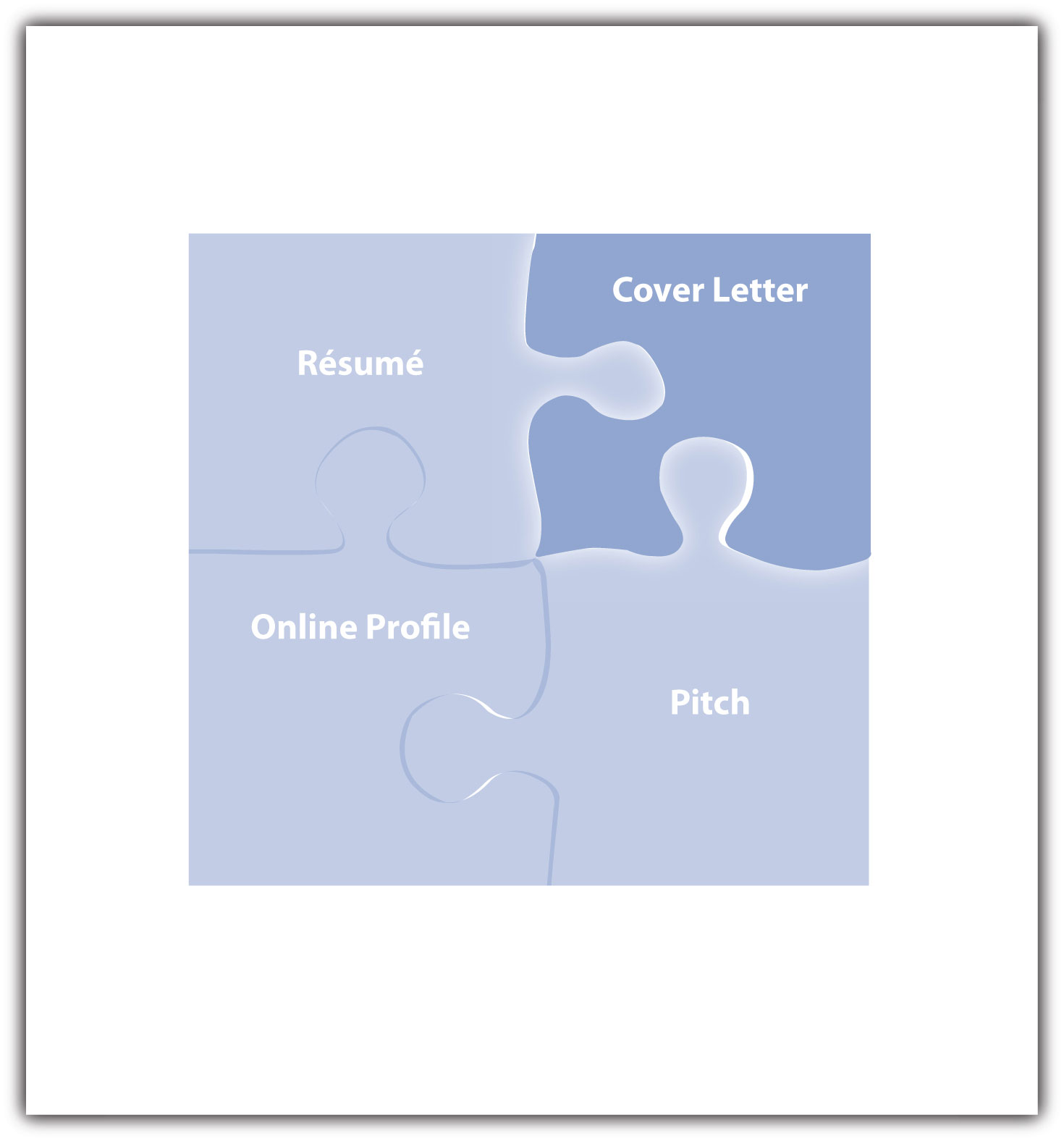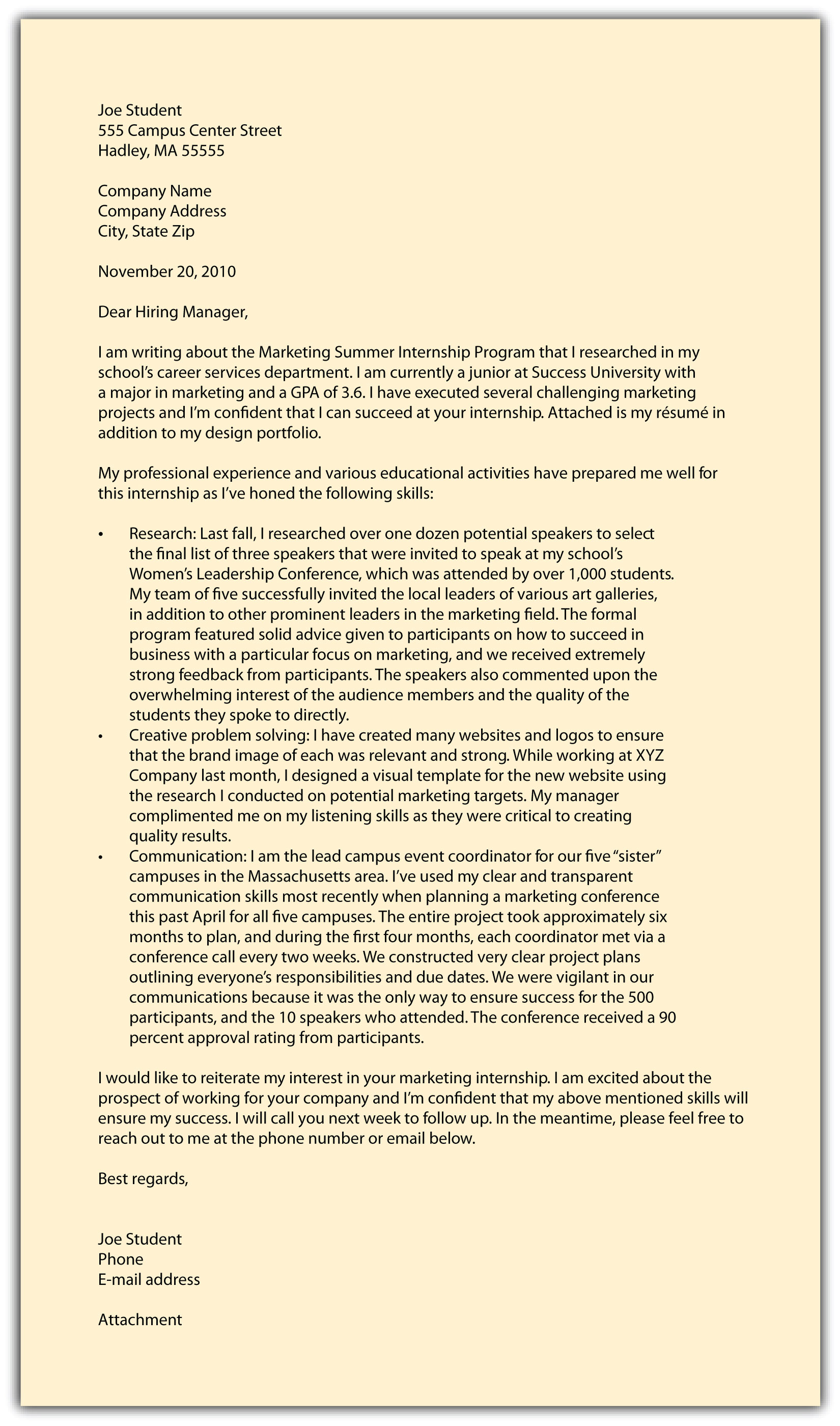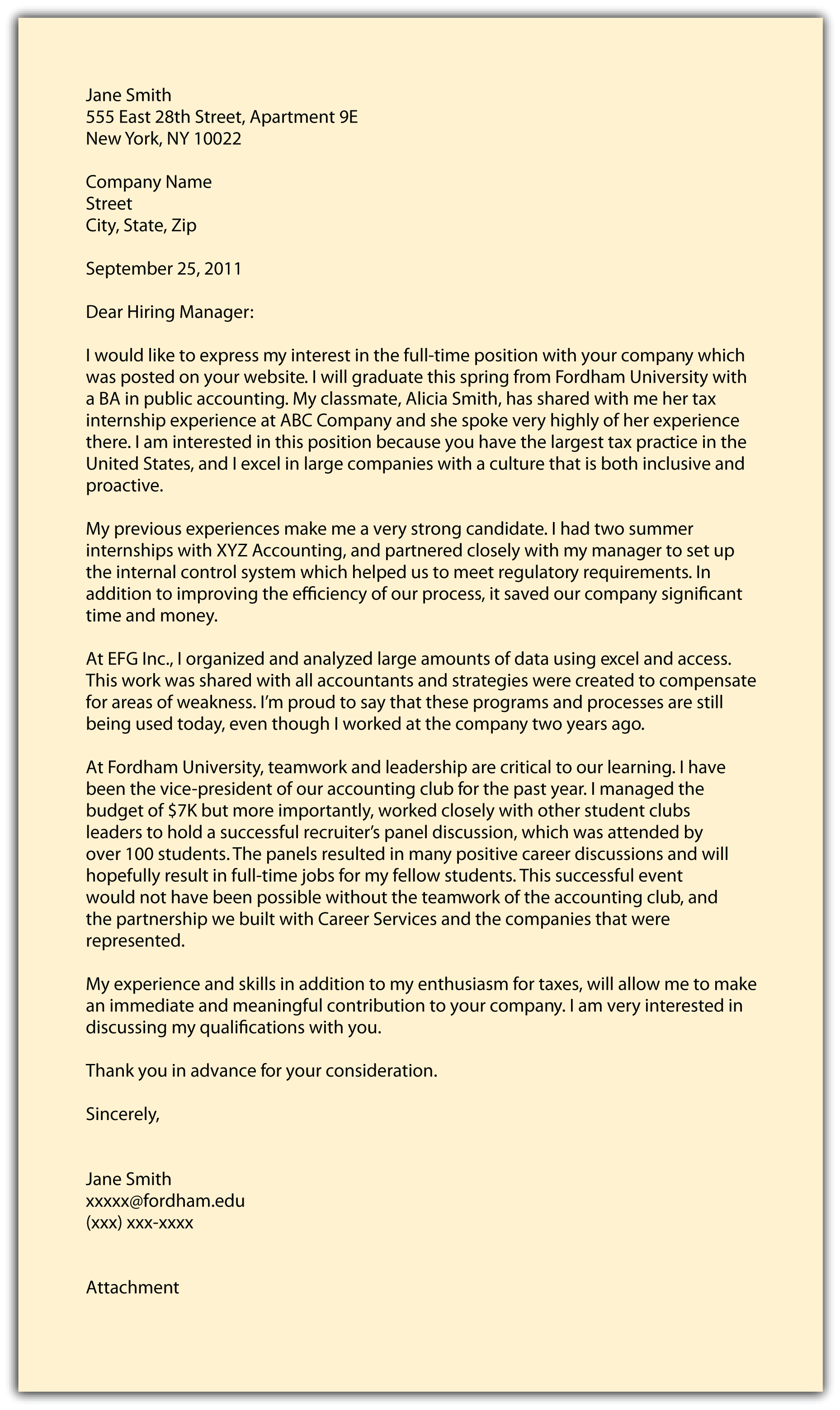Is it worth writing a cover letter knowing it might never be read? The short answer is yes. Some recruiters don’t read cover letters and go straight to the résumé, but other recruiters read and carefully weigh the information in cover letters. You don’t know which recruiter will receive your résumé and letter, so write the best cover letter you can. A well-written cover letter is an opportunity to present yourself well and influence a recruiter, so always take full advantage of that opportunity. A cover letter can also be viewed as your first conversation with a future employer, so be certain its quality is exceptional.
Your cover letter should be engaging, informative, and show your command of the written word. It should flow easily from a reader’s perspective, making the connection between the opportunity and your ability to succeed if given the chance. The tone should be compelling. You should be excited about the opportunity and you should be confident of your ability to succeed (even if you truly lack the confidence).
Cover Letter Preliminary Work
Preparation and practice are critical to every step of the job search process, and the cover letter is no different. Five actions can help make your cover letter compelling:
- Make a list of your top ten strengths.
- Make a list of your top five weaknesses (also known as areas you’d like to strengthen).
- Decipher the job description to identify each separate skill and qualification.
- Compare the two lists to see if they are in alignment. Also identify the gaps—does the job description list something that you haven’t done?
- Highlight your top three skills that align with the job description as you will use them in your cover letter.
List Your Top Ten Strengths
Knowing your top strengths is vital to your job search efforts. To find your top strengths, assess your past successes. Fill out the following chart, and, next to each strength, list a detailed example of how you have excelled at this particular strength. Quantify as much of your example as possible, and ensure you include a clear beginning, middle, and end. Table 5.1 "Chart of Top Strengths" lists an example for your reference:
Table 5.1 Chart of Top Strengths
| Top Strengths |
Examples |
| 1 |
Organized |
- In my last internship, I was asked to manually organize paper work for the past year's real estate transactions, with little other direction.
- I was given two weeks to complete this, and all of the paper work was in approximately five boxes.
- I quickly reviewed the contents, which fit into four categories: (1) commercial, (2) private homes, (3) condos, and (4) incomplete transactions.
- I asked my manager to review this to make sure I was going in the right direction. He gave me the green light.
- I finished the project in one week, and I not only organized the files but also computerized the entire process.
- As a result, my manager quickly focused on completing 25% of the outstanding transactions, adding ~$100K in the last half of the year!
|
| 2 |
|
|
| 3 |
|
|
| 4 |
|
|
| 5 |
|
|
| 6 |
|
|
| 7 |
|
|
| 8 |
|
|
| 9 |
|
|
| 10 |
|
|
Notice that the example is very detailed:
- Time was referenced (in a few ways): This project was during your last internship, and you had two weeks to complete the task. The work was actually finished ahead of schedule—in one week versus two.
- The duties were defined: You had to organize the contents of boxes of paper work for the year’s real estate transactions.
- The action was emphasized: You took the initiative to organize the work into four categories and you checked with your manager to make sure you were going in the right direction.
-
The accomplishment was highlighted: You completed the task in half the time, and you automated the process. Most of all, you enabled your employer to close 25 percent of the outstanding transactions, adding about $100,000 in revenue to the bottom line.
(Whenever possible, identify the result(s) of your actions. Future employers will hire you because you have proved your worth to your past employers.)
Other strengths and skills could include (in alphabetical order):
List Your Top Five Weaknesses
Many job search candidates are uncomfortable talking about their weaknesses. This should not be the case. Knowing your weaknesses is just as important to your job search as knowing your strengths. Three very strong reasons exist to speak fluidly and confidently about your weaknesses:
- Employers want to hire individuals who are self-aware, and you can be self-aware only if you know both your strengths and weaknesses. Being self-aware is the only way you can improve.
- Employers know it takes a certain level of maturity to talk about your weaknesses. They want to ensure you have achieved that level of maturity before extending an offer.
- Your weaknesses should in no way contain a hint of the skills necessary to excel at your target position. Your weaknesses should in no way contain a hint of the skills necessary to excel at any position.
Remember that everyone has strengths and everyone has weaknesses, including every CEO, every country’s president, every manager, and every one of your coworkers. You will be in good company when considering and discussing your weaknesses.
The trick, if there is a trick, to your weaknesses lies in your plan to strengthen them. Having a plan to strengthen a weakness is impressive, especially if you’ve already taken steps to do so.
Table 5.2 "Chart of Weaknesses" will help you identify five weaknesses, or areas you’d like to improve.
Table 5.2 Chart of Weaknesses
| Weaknesses |
Plan to Strengthen |
| 1 |
Public speaking |
- I have given many presentations, and on a scale of 1–10, I’m probably a 6. I do my best when I’m very prepared and when I rehearse.
- To improve, I’ve registered for a public speaking class next semester, and until then, I raise my hand more than usual.
- I also volunteer to present whenever I can because the more I practice, the better I get. Lastly, I’m reading a book about presenting, and it’s helped very much.
|
| 2 |
|
|
| 3 |
|
|
| 4 |
|
|
| 5 |
|
|
Notice that the weakness is specifically described with a plan for improvement:
- You are aware that public speaking is a weakness, yet you‘ve already given presentations, are not an abysmal failure in this area, and have already achieved some success.
- You quantified where you are on a scale of one to ten and consider yourself a six. You have shown that you know the topic well, but haven’t yet mastered it. You mention two important aspects to being a good presenter: (1) you do best when you are prepared and (2) rehearsal and practice help you as well.
- You already have a plan to strengthen this skill: (1) you will take a public speaking class, (2) you are raising your hand as much as possible in class (which is a form of public speaking), (3) you are volunteering to present whenever you can, and (4) you are reading a book about presenting and it’s already helped.
In addition, it’s important to note that a weakness should never be a core component of the job. For example, if you perceive your weakness to be public speaking, you wouldn’t apply for a position as a trainer. If you perceive your weakness to be analytical skills, you wouldn’t apply for a position as an accountant. A weakness can be a part of a job, for example, if you are applying for a position as an accountant, you would predominately do financial work and only sometimes present (e.g., share your findings with management), so using public speaking as a weakness in this case is fine.
Decipher the Job Description and Identify Each Skill and Qualification
Most job descriptions can be copied from the employer’s website. Copy the job description and do the following (if you only have a hard copy, it’s worthwhile to retype it as you’ll want to manipulate each requirement for the position):
- Put each skill and qualification on a separate line.
- Group like with like. If communication skills are listed as important, in addition to giving presentations to potential clients, list one after the other.
In the following sample, each component of the job description is considered and deciphered, in preparation for applying and eventually interviewing for the position.
Job Description Sample
Entry-Level Sales
The CML Company, a leading provider of recruiting and staffing services, is currently seeking motivated, career-oriented individuals to join our recruiting team.
Our recruiters work with our clients and inside sales team identifying, screening, interviewing, and presenting qualified candidates for contract and permanent positions.
CML promotes from within. Entry-level sales staff start as recruiters. Once they master that role and have a desire to become a member of our sales team, they can be considered for promotion.
Qualified Candidates for the Recruiter Position Will
- Develop recruiting strategies designed to identify qualified candidates through various recruiting tools.
- Evaluate candidates’ strengths compared with clients’ requirements by evaluating, screening, and interviewing the candidate.
- Negotiate wage rates and other terms and conditions of employment with candidates, and gain commitment from candidates for current and future job requirements.
- Complete necessary preemployment processes, including reference and background checks and drug tests.
- Work with account executives to identify top accounts, client skill sets, and key market segments, and to assess clients’ staffing requirements.
- Communicate effectively with others to create a productive team environment.
- Communicate with peers by sharing recruiting best practices and providing accurate, thorough documentation on contract employees in our applicant-tracking system or by using other documentation tools.
- Maintain relationships with industry contacts to provide customer service, gain industry knowledge, and get referrals and sales leads.
Qualified Candidates for the Recruiter Position Must
- Have a bachelor’s degree or related sales or recruiting experience
- Be available to work before and after typical office hours as work may demand
- Possess strong written and oral English communication skills
- Be familiar with Microsoft Word and MS Outlook (or similar e-mail applications)
- Have work experience in a service-oriented business
- Have a desire to learn and advance in a fast-paced sales environment, and be capable of regularly using good judgment and discretion to accomplish goals and work requirements
- Be currently authorized to work in the United States for any employer
Requirements:
- Bachelor’s degree
- Able to work flexible, long hours
- Strong written and verbal communication skills
- Computer literate
- Desire to learn in a fast-paced sales environment
- Good judgment
- Discretion
- Currently authorized to work in the United States
Review the Job Description Sample
Consider the preceding sample. Study each component of the job description and how it relates to your skills so you can apply for and gain an interview for the position:
- Eight items are listed in the requirements section. Do your skills match all of these requirements, or the vast majority of them? It would be wise to compare this list to your list of strengths.
- An additional three requirements are not stated as obviously: (1) individuals must be motivated, (2) they must have the ability to master the work, and (3) they must have a desire to be a part of the sales team in order to be promoted. These requirements are found in the first section of the job description.
- Don’t count out the opportunity if you don’t fit every requirement. Do your best to think of something that is somewhat related. For example, if you have never worked in a fast-paced sales environment, focus on your desire to learn. Focus on the fact that you’ve observed fast-paced sales environments, and those situations appeal to you. At the very least, you could think of the fact that although you don’t have direct experience in that particular environment, you have always been very proactive in completing tasks as quickly and efficiently as possible.
- If you are a strong match for the majority of the requirements, ensure you have specific, results-oriented examples to demonstrate these skills.
- You will not have a clear indication as to which skills are more important than others, so use your best judgment call. Treat each skill as if it’s the most important. For example, consider communication skills—have a specific, results-oriented example of your verbal skills and your written skills. At some point, however, you will want to select the three skills you think are most important, match them to your strongest skills, and then write your cover letter.
Consider Future Responsibilities of the Job
Note that it’s not necessary for you to know how to develop recruiting strategies. You can learn that on the job. However, a proactive candidate may research recruiting strategies and the identification of talented individuals.
Compare the Two Lists and Find the Alignment between Your Strengths and Weaknesses
You now have taken the following two steps:
- Deciphered the job description into each individual skill and requirement needed
- Listed your top ten strengths, with examples for each
Your next step is to check if the two lists are aligned:
- If there is alignment, you have a potential good match and you should apply for the job.
- If there isn’t alignment, it’s a clear indication that the job is not the right fit for you and it’s best to continue your search.
Highlight Your Top Three Strengths
The last step in this section is to select the top three skills needed in the job description, and decide which skills fall within your strengths and which you will highlight in the cover letter. These three skills, if positioned properly, will make the case for why you should be hired.
The Cover Letter Template
The cover letter template includes three main sections:
- The introductory paragraph
- The last paragraph, which reiterates your interest
- The magic middle
The Introductory Paragraph
In the introductory paragraph, you introduce yourself to the hiring manager or recruiter. The paragraph should include five general items:
- Why you are contacting them
- How you heard about the position (If someone referred you, mention the name of your contact.)
- Whether you are still in school and, if so, your major and minor
- How your work experience pertains to your desired or targeted job
- Why you are interested in the position
The Last Paragraph
In the last paragraph, you summarize and close, taking the following five steps:
- Reiterate your interest.
- State you would be a perfect match because your strengths match the key skills necessary to succeed at the job.
- Inform them that you will contact them in a week.
- Ask that they contact you should they have any questions or an interest in moving forward.
- Thank them for their time and consideration.
The Magic Middle
The middle of the cover letter is magical because it makes the case for why you’d be an exceptional hire. Select three strengths necessary to excel and assign each strength to a bulleted section or brief paragraph. Boldly indicate your strengths and include your best examples of how you excel at each strength. See the following sample cover letter as an example of how to highlight your strengths.
Creating a Portfolio: Show and Tell
If you have examples of your expertise in a particular discipline, consider creating a portfolio of that information to share with potential employers. For example, perhaps you are a communications major and have written several documents that showcase your talent in this area. Include five or six samples of your communications to help build the case for why you should be hired. Perhaps you are a graphic design candidate, and you created several visuals that were used by neighborhood businesses, or for a class project. Include those visuals in a portfolio to help prove your talent to a future employer.
How would you share this information with future employers? You can either attach your samples, along with your résumé and cover letter, in your e-mail to a future employer, or bring them with you when you have secured an interview. Either method is an acceptable way to impress a future employer. A portfolio that you can carry to an interview could simply be a neat and professional-looking folder that contains hard copies of your work. Or you can include a virtual portfolio of online work with a link an employer can use to view your samples. You can include this information in a cover letter and you can also include it in a résumé. Either way, having samples and presenting them can prove to future employers that you have the talent to succeed.
Miscellaneous Things to Consider
Format
Formatting is important and must be neat and professional. It’s recommended that you flush all text to the left, as various software programs can wreak havoc with indentations and tabs.
Greeting
Put extra effort into identifying the name of the hiring manager, so that your letter can be appropriately addressed to the specific person who will be reviewing résumés. Employers do not make this an easy step for you, and you have to do your research. Helpful exercises include researching the company website, reading news releases, and even calling the company to ask. Laziness will hurt your job search effort if this special effort is not made. If, after doing all the preceding, you still do not know the name of the person to whom you are sending your information, by all means, address it using Dear Hiring Manager or Dear Recruiter.
Key Takeaways
- A cover letter should not repeat a résumé.
- You need to specifically align your strengths with the job qualifications to create a compelling cover letter.
- A cover letter includes three things: the introductory paragraph, the closing paragraph, and the magic middle, where you highlight how your strengths align with the job.
- Simple is best when considering a cover letter format.
Exercises
- What are your top ten strengths, and what examples will you use to prove those strengths?
- Identify three to five weaknesses (or areas you’d like to strengthen). Create a plan to strengthen each of your weaknesses.
- Find a job description that interests you and decipher it into each individual skill.
- Find at least two to three job descriptions where you are a strong match.
- What resources can you use, in addition to this textbook, to write your cover letter?
- Draft your cover letter and pair up with a peer in your class and critique each other’s letters.



